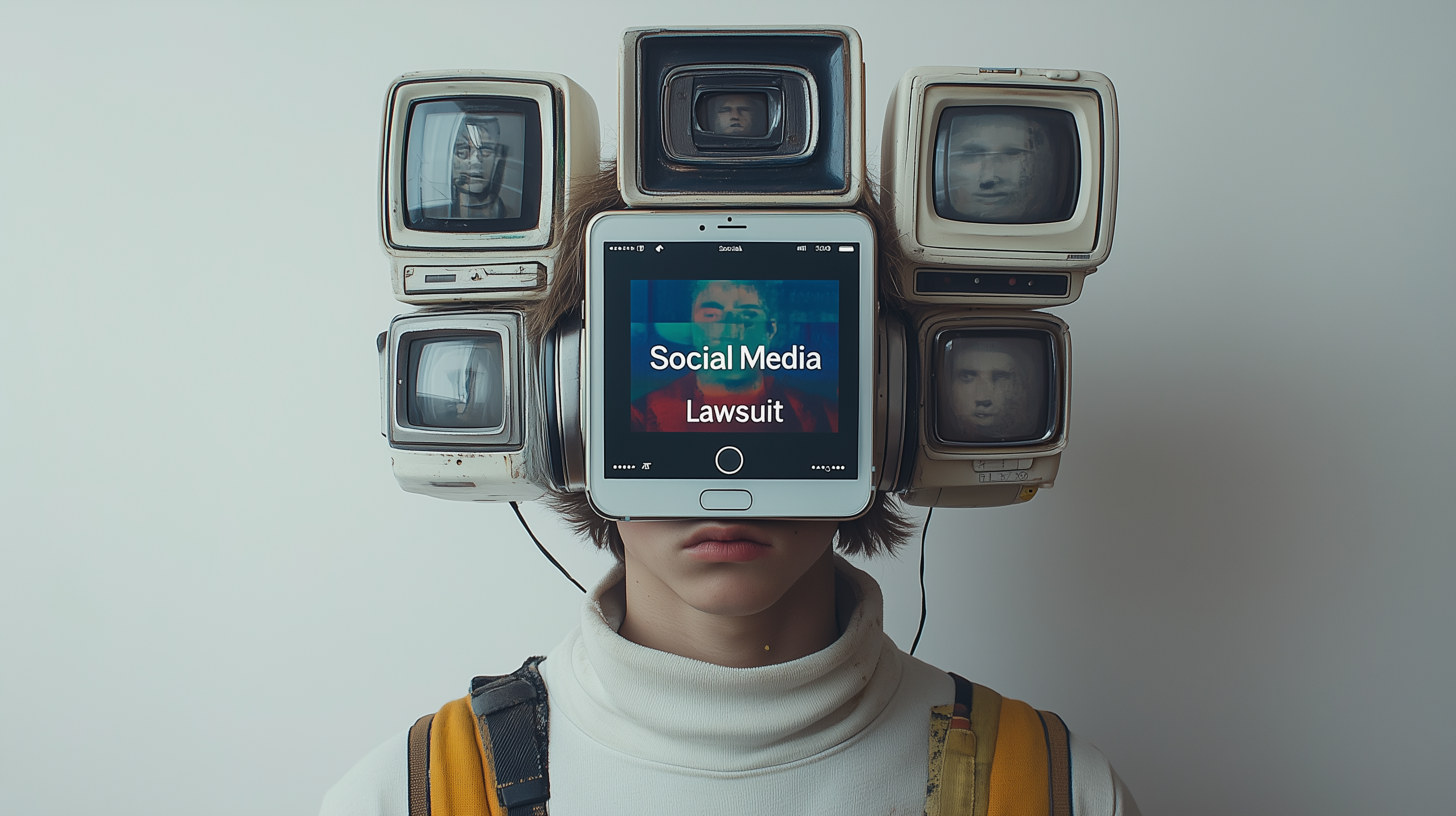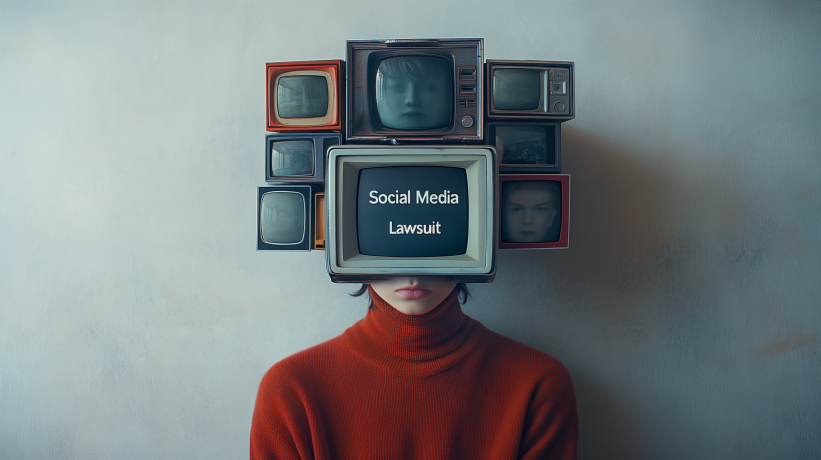
Social media giants face a landmark lawsuit from Granville County schools, alleging their addictive designs fuel a youth mental health crisis. This case could fundamentally alter how tech companies approach user engagement and safety, potentially reshaping the digital landscape for generations to come.
by LawInc Staff
August 9, 2024
Granville County Public Schools Board of Education has filed a groundbreaking lawsuit against several major social media giants, including Meta (Facebook/Instagram), Snap, ByteDance (TikTok) and Google (YouTube). The school district alleges these companies have intentionally designed addictive platforms that have fueled a youth mental health crisis, substantially harming students and schools.
This guide breaks down the key claims, evidence, legal theories and potential impact of this landmark case. Dig into the complaint’s allegations about how these tech titans engineered their products to exploit vulnerable children and learn what the school board hopes to achieve through this major legal action.
From the science of social media addiction to the nuts and bolts of public nuisance and product liability claims, this comprehensive explainer has you covered. Get up to speed on this consequential case and what it could mean for the future of how social media interacts with young users.
1. Allegations Against Social Media Giants
-
- Designing Addictive Products: Defendants purposefully designed platforms to be addictive to youth to maximize engagement and profit.
- Employing Psychological Manipulation: Products exploit teens’ developmental vulnerabilities via features like intermittent variable rewards and social comparison.
- Causing Mental Health Harms: Excessive platform use has fueled rising rates of depression, anxiety, eating disorders, self-harm and suicide among youth.
- Lack of Safeguards: Defendants failed to implement adequate age verification, parental controls and content moderation to protect young users.
- Misrepresenting Safety: Companies touted products as safe while internally research showed platforms’ negative impact on teens’ wellbeing.
Key Evidence Cited:
-
- Leaked internal Meta studies finding Instagram made body image issues worse for 1 in 3 teen girls and 13.5% of U.K. teen girls reported increased suicidal thoughts after using Instagram.
- MRIs revealing that compulsive use of defendants’ apps measurably alters adolescent brains’ neural sensitivity and rewards processing.
- From 2009-2019, the rate of U.S. high schoolers persistently feeling sad or hopeless rose 40% alongside skyrocketing teen social media usage rates.
- TikTok’s defective age controls allowed bots posing as minors to rapidly access a stream of videos about sex, drugs and eating disorders.
- Meta’s internal messaging touting Instagram as a “pipeline” to attract and retain young teen users despite knowing the risks to their wellbeing.
The Argument:
-
- The plaintiff contends the evidence shows the defendants knew their products could harm young users but prioritized profit over implementing crucial safety measures.
- By designing platforms to capitalize on teens’ brain chemistry and maximize time spent on the apps, the defendants directly facilitated a rise in problematic use.
- The school district argues the resulting mental health crisis has drained public resources, disrupted the learning environment and forced schools to divert attention to address students’ worsening wellbeing.
- The school board alleges the companies’ conduct went beyond organizing user-generated content to intentionally creating addictive products without adequate precautions.
- Essentially, the defendants recklessly pursued growth at all costs while misrepresenting the dangers, so they should be held accountable for the public nuisance created.
Key Counterarguments to Expect:
-
- Section 230 immunity: Defendants will likely argue they are shielded from liability for third-party content on their platforms under Section 230 of the Communications Decency Act.
- Lack of proximate causation: Companies may contend there are too many environmental, genetic and familial factors impacting teen mental health to isolate social media as the definitive cause.
- Assumption of risk: Defendants could assert teens assume the risk of any negative impacts when they voluntarily choose to use the platforms.
- Free speech rights: Social media giants may frame content moderation demands as impinging on their First Amendment rights to display user-generated content.
- Existing safety measures: Expect the companies to highlight existing youth protection features in their apps and characterize demands for more as unnecessary and burdensome.
2. Nuisance and Product Liability Claims Unpacked
-
- Public Nuisance: The platforms’ addictive design has unreasonably interfered with public health and safety, disrupting school operations.
- Negligent Design: Despite knowing the risks to minors, defendants failed to design their products with reasonable safeguards for young users.
- Failure to Warn: Companies didn’t adequately warn families about foreseeable harms to teens’ mental wellbeing from their platforms.
- Gross Negligence: Defendants acted with reckless disregard for minor users’ safety by prioritizing growth over implementing known solutions.
- Willful & Wanton Conduct: Social media giants consciously pursued a course of action with knowledge it would likely cause substantial harm to youth.
Elements of Public Nuisance Claim:
-
- Condition: Defendants created a condition in their products injurious to youth health, safety and welfare.
- Public Right: Defective platforms affect entire communities of young people, not just individuals.
- Control: Companies control the design, release and operation of their own products and algorithms.
- Proximate Cause: Excessive social media use directly caused by defendants’ choices has fueled youth mental health crisis.
- Unique Damage: As primary youth mental healthcare provider, school district has incurred outsized costs and burdens to address fallout.
Elements of Negligent Design & Failure to Warn Claims:
-
- Duty: As operators of platforms widely used by youth, defendants owed a duty of care to make products reasonably safe and warn of risks.
- Breach: Companies breached this duty by not implementing safeguards to prevent excessive use and addiction among minors despite known hazards.
- Cause: But for lack of safety features and warnings, young users would not have experienced such high rates of problematic use and resulting harms.
- Foreseeable Harm: It was reasonably foreseeable that exploitative design and lack of precautions would lead to overuse and mental health issues in teens.
- Damages: School district has diverted extensive resources to address student wellbeing fallout, e.g. more counselors, disciplinary action, interrupted learning, etc.
Special Considerations:
-
- Products vs. Platforms: Presenting social media apps as defectively designed “products” vs. “platforms” for user content aims to limit Section 230 protections.
- Research as Notice: Studies on social media’s youth mental health impact put defendants on notice of risks their design choices could cause to young users.
- Ultrahazardous Activity: Complaint stops short of alleging teen-targeted social media is an “ultrahazardous activity” (like toxic chemicals) warranting strict liability.
- Attractive Nuisance: Framing addictive platforms as an “attractive nuisance” luring in vulnerable kids could shape duty of care owed to minors.
- Joint & Several Liability: Arguing defendants acted in concert and plaintiff isn’t at fault aims to tag companies with total damages, not partial fault.
3. Breaking Down Specific Platform Features at Issue
-
- Engagement-Driven Algorithms: Platforms employ machine learning to maximize user time on app, often exposing youth to harmful content.
- Intermittent Variable Rewards: Like slot machines, features such as “likes,” “streaks,” and “followers” exploit the brain’s dopamine reward system.
- Endless Scrolling: Autoplay and infinite scroll features induce a constant flow state, urging users to keep consuming content.
- Reciprocity and Social Comparison: Apps exploit teens’ natural desire for social status and approval and promote negative self-comparison.
- Challenges and Image Filters: Viral challenges and appearance-altering filters encourage risky behavior and fuel body dissatisfaction.
Meta’s Problematic Practices:
-
- Meta designed its algorithms to promote posts likely to elicit intense reactions, often pushing users into a vicious cycle of negative content.
- Instagram’s feed, “explorer” page and emphasis on influencers promote impossible beauty standards and appearance-focused social comparison.
- Snapchat’s “snap streaks” and “best friends” features quantify teens’ social worth and instill anxiety about maintaining connections.
- Facebook’s and Instagram’s deficient age controls allow kids under 13 to readily create accounts and instantly access mature content.
- Disappearing messages and “stories” on both apps raise risks of teen sexting and predation by creating a false sense of impermanence.
TikTok’s Manipulative Methods:
-
- TikTok’s algorithm relentlessly learns individual users’ interests, raising risks of “rabbit hole” exposure to dangerous or explicit content.
- Short video format and endless scroll design keeps vulnerable young brains locked in a constant dopamine-driven feedback loop.
- Viral dance, prank and challenge trends frequently encourage risky behavior in pursuit of views, likes and social validation.
- “For You” page recommendations rely on watch time as key engagement metric, yet offer no in-app way to set reasonable time limits.
- Beauty filters create unrealistic expectations and dysmorphia while normalizing plastic surgery-type facial alterations.
YouTube’s Addictive Aspects:
-
- Autoplay: Default autoplay setting on home and “Up Next” features creates a never-ending stream of sticky content without requiring user action.
- Recommendations: Suggested videos can quickly lead young users down concerning content pathways, e.g. searches on dieting lead to pro-anorexia videos.
- Incognito Mode: Easy anonymous viewing without logging in reduces barriers to underage use and accessing inappropriate videos.
- Comment Rabbit Holes: Comments on innocuous kid videos can lead to predatory interactions luring children to more sexual content.
- Ad Incentives: Allowing minors to profit off potentially harmful content via Partner Program monetizes risky teen behavior.
4. Unpacking Potential Impacts of the Case
-
- Compensating Schools: Recover costs districts have incurred to respond to social media-fueled youth mental health fallout.
- Industry Reform: Pressure platforms to radically reform kid and teen-targeted design practices to prioritize wellbeing over engagement.
- Expanding Oversight: Pave the way for increased regulatory scrutiny and enforcement of youth-directed social media services.
- Evolving Liability Landscape: Chip away at Section 230 immunity and reframe platforms’ legal duties to protect vulnerable users.
- Empowering Parents: Arm families with information to make safer social media choices and prompt frank conversations with kids.
Key Relief Sought:
-
- Damages: Monetary compensation for costs the school district has incurred addressing student mental health and disciplinary issues tied to defendants’ apps.
- Abatement Order: Court order forcing defendants to cease operating platforms in a way that creates a public nuisance to youth well-being and school functioning.
- Injunction: Order barring companies from continuing to engage in youth-targeted design practices court deems unlawful and requiring curative measures.
- Medical Monitoring: Potential fund to allow ongoing screening and treatment for youth who have suffered mental health impacts from defendants’ products.
- Prevention Education: Programs to educate students, staff and families about identifying problematic social media use and fostering healthier digital habits.
Challenges to Overcome:
-
- Section 230 Defense: Defendants will argue they are mere “platforms” not liable for user-generated content. Plaintiffs must show design choices go beyond traditional publishing.
- Causation Hurdles: Establishing clear causal link between platform use and specific mental health harms amidst myriad contributing factors will require strong data.
- Jury Challenges: Conveying complex technical concepts and alarming youth impact evidence to jurors in accessible, emotionally resonant way.
- Defining Fixes: Court may be reluctant to dictate specific product changes, so plaintiff must present viable reform framework.
- Scope of Liability: Case could open floodgates for other districts to sue, so court will carefully consider limiting principles on platform duties.
Potential Ripple Effects:
-
- More Plaintiff Suits: If Granville County prevails, expect a surge in similar school board cases and expansion to suits by parents, youth users directly.
- Legislative Push: Findings could boost prospects for proposed laws like Kids Internet Design & Safety Act limiting addictive design elements.
- FTC Action: Evidence uncovered may arm Federal Trade Commission to investigate deceptive youth marketing or privacy violations.
- Global Impact: As with GDPR, any mandated US safety reforms would likely force platforms to change policies worldwide.
- Cultural Shift: Increased awareness of manipulative design could accelerate “techlash” and spur families to delay/limit youth social media use.
Summary

Did You Know? 46% of US teens report having a hard time leaving social media, despite 36% saying they spend too much time on the apps. The Granville lawsuit alleges design tricks keep kids hooked.
The Granville County school board’s sweeping lawsuit against social media juggernauts centers on two key assertions: 1) platforms are defectively designed “products” not mere “publishers” of third-party content, and 2) those addictive design choices fueled a burgeoning youth mental health disaster.
From autoplay to intermittent rewards to algorithmic rabbit holes, the complaint argues baked-in platform features exploit developmental weak spots to keep kids hooked. Though this “public nuisance” framing faces legal hurdles, damning internal research and surging rates of teen depression, self-harm and suicidality paint a compelling picture.
While courts will carefully weigh expanding tech liability and mandating reforms, the plaintiff’s goal seems clear – force a long-overdue reckoning over the true costs of social media’s unchecked “attention extraction” model on a generation of young minds. At stake is no less than rebalancing the scales between child wellbeing and big tech’s bottom line.
Test Your Granville Lawsuit Knowledge
Questions: Claims & Legal Theories
-
- 1. What is the key public nuisance claim in the Granville lawsuit?
- A) Platforms violate CDA Section 230 by hosting third-party content
- B) Companies’ addictive app design fuels youth mental health crisis
- C) Social media causes societal productivity losses from excessive use
- D) Defendants engaged in false advertising about products’ safety
- 2. What product liability theory does the complaint heavily rely on?
- A) Negligent design of platforms failing to protect young users
- B) Strict liability for algorithm-amplified harmful content
- C) Breach of implied warranty of merchantability for dangerous apps
- D) Violation of state consumer protection laws against unfair practices
- 3. What gross negligence argument does the complaint advance?
- A) Platforms have a special duty of care as publicly traded companies
- B) Companies recklessly ignored risks to youth to boost engagement
- C) Defendants failed to comply with FTC children’s privacy rules
- D) Apps illegally collected data on users under 13 without consent
- 4. Why does the suit emphasize platform features as key drivers of harm?
- A) To present apps as dangerous “products” not passive “publishers”
- B) To implicate execs’ personal liability for corporate policy decisions
- C) To narrow claims to UI decisions immune from Section 230 defense
- D) To suggest platforms directly produce harmful content themselves
- 5. What’s a key challenge the plaintiff must overcome on causation?
- A) Ruling out other genetic or environmental mental illness causes
- B) Definitively proving increased social media use preceded crisis
- C) Showing offline school behavior stemmed from online activity
- D) All of the above could complicate proving causation
- 1. What is the key public nuisance claim in the Granville lawsuit?
Answers: Alleged Harms & Supporting Research
-
- 1. B) The core public nuisance claim asserts platforms’ addictive design fuels a youth mental health crisis that interferes with school operations.
- 2. A) Negligent design features prominently, arguing companies failed to implement reasonable safeguards despite foreseeable risks to minors.
- 3. B) Complaint alleges gross negligence by defendants in recklessly prioritizing user engagement over known dangers to youth wellbeing.
- 4. A) Framing defective platform features as key drivers of harm aims to present apps as “products” to avoid Section 230 immunity for publishers.
- 5. D) Plaintiff must overcome defense arguments that many confounding factors beyond social media, from genetics to offline stressors, contribute to youth mental health woes.
Questions: Alleged Harms & Supporting Research
-
- 1. What key youth mental health stats does the complaint cite?
- A) Doubling of teen girls with suicide plans from 2009-2019
- B) Over 40% rise in students reporting persistent sadness 2010-2020
- C) 1 in 5 teen girls seriously considered suicide attempts by 2019
- D) All of these alarming trends are highlighted in the complaint
- 2. What types of problematic content does the lawsuit allege platforms push?
- A) Posts idealizing thinness and promoting eating disorders
- B) Violent videos of fights, stunts and self-harm acts
- C) Sexualized images and pornographic material
- D) The complaint cites examples of all these and more
- 3. What age group does the complaint say is most vulnerable to social media harms?
- A) Preteens whose under-developed brains are prone to peer pressure
- B) Adolescents in key stage of forming personal identity and values
- C) Young adults transitioning to independent decision-making
- D) The so-called “Zillennials” born after the year 2000
- 4. What internal company research is most damning to Instagram?
- A) Surveys showing most users want to spend less time on app
- B) Findings that use makes body image issues worse for 1 in 3 teen girls
- C) Data showing marked decline in posting frequency by young users
- D) Insights on most popular face filters creating unattainable looks
- 5. What evidence suggests defendants knew their products could be addictive?
- A) Public statements by execs analogizing features to slot machines
- B) Emergence of “social media addiction” as coined research term
- C) Insider engineer concerns over “attention extraction” techniques
- D) The complaint points to all these red flags and more
- 1. What key youth mental health stats does the complaint cite?
Answers: Alleged Harms & Supporting Research
-
- 1. D) The complaint paints an alarming picture of youth mental health deterioration in the 2010s coinciding with surging social media use.
- 2. D) From extreme dieting to graphic violence to underage sexualization, the lawsuit argues platforms perpetuate a spectrum of harmful content.
- 3. B) The complaint emphasizes adolescents’ unique developmental vulnerabilities to social reward-seeking and external validation needs.
- 4. B) Meta’s own researchers concluded Instagram worsens body image for a significant subset of teen girls, contradicting public safety assurances.
- 5. D) From insider warnings to addiction research to damning exec soundbites, the complaint argues defendants had ample notice of abuse risks.
Also See
Instagram on Trial: Teens Sue Meta for $5B in Landmark Addiction Case










